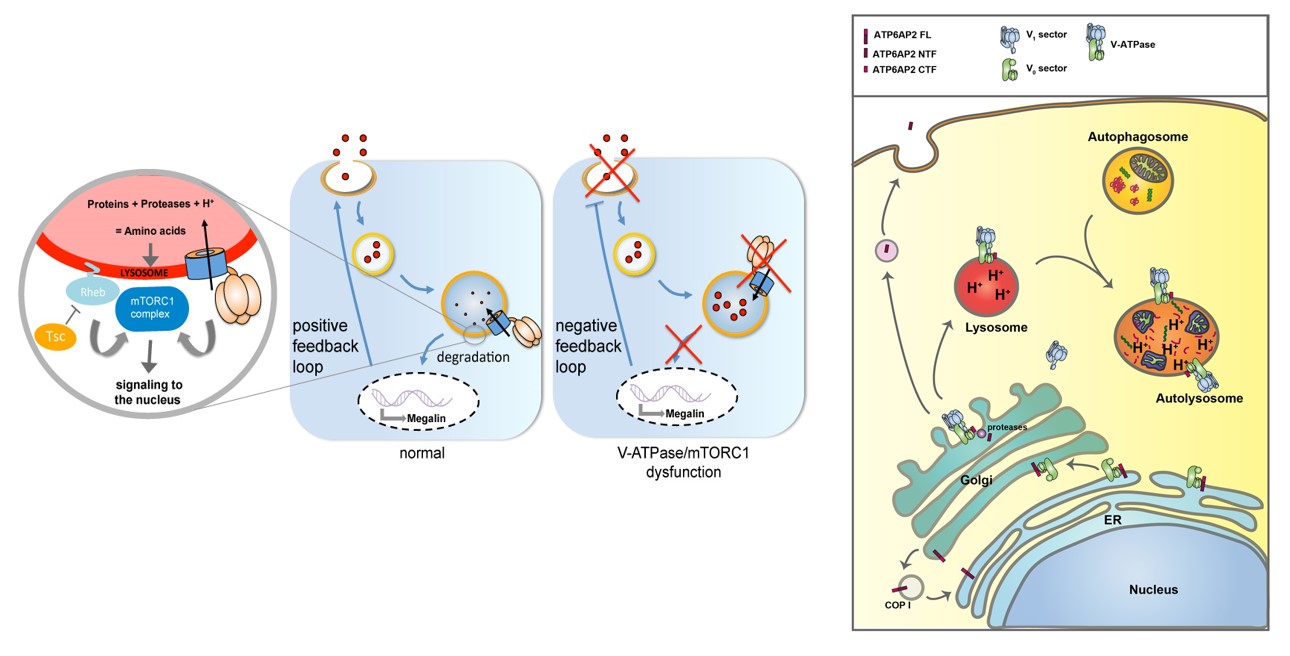Laboratory of epithelial biology and disease
INSERM UMR 1163Institut Imagine
24, Boulevard du Montparnasse
75015 Paris - Paris
Site web - matias.simons@institutimagine.org -
Principal investigator
Matias Simons, Directeur de recherche (INSERM), PI, Liliane Bettencourt

Research themes
Mutations in ATP6AP2 cause autophagic liver disease: A long-standing goal of the lab has been to functionally characterize ATP6AP2 (also known as the (pro)renin receptor). Our results suggest that this protein contributes to the assembly of the proton pump V-ATPase in the endoplasmic reticulum. Through this role, it has a fundamental impact on various signaling pathways (PCP, Wnt, Notch, mTOR etc.) (Hermle et al, 2010, 2013; Trepiccione et al, 2016; Guida et al, 2018). We also found that mutations in ATP6AP2 cause syndromic steatotic liver disease with severe problems in autophagic clearance due to insufficient lysosomal acidification (Rujano et al, 2017; Cannata Serio et al, 2018). We are currently characterizing additional players in V-ATPase assembly as well as their human mutations.
Drosophila as a tool in human genetics: The understanding of human genetic diseases has been greatly improved by novel techniques, such as next generation sequencing, allowing the complete genotyping of vast numbers of affected individuals and their relatives. However, the evaluation of the pathogenicity of genetic variants remains a major bottleneck, because the human genome still lacks important functional gene information. An important goal of the lab is to employ the Drosophila model as an innovative toolkit for the rapid identification of novel genes for hereditary diseases, particularly in the area of kidney disease (Gerber et al, 2016; Cavallin et al, 2017; Lovric, Goncalves et al, 2017; Goncalves et al, 2018).
Lysosomal signaling in proximal tubular cells of the kidney: In the kidney, our main organ of interest, there are a number of different epithelial cells organized in segments along the nephron, and we are particularly interested in the proximal tubules. Epithelial cells of the proximal tubules have a very active endolysosomal system, and this is because its main task is to reabsorb virtually all the proteins that are filtered by the glomerulus. For this, the apical brush borders are equipped with a dedicated protein uptake pathway, involving the multiligand receptors Megalin and Cubilin. Failure of this pathway results in low-molecular-weight proteinuria, which is a hallmark of proximal tubulopathies (e.g. cystinosis and Dent’s disease). Our recent research in Drosophila has introduced a novel mechanism for the control of apical protein uptake with strong implications for proximal tubular cells (Gleixner et al., 2014). Our findings propose that lysosomal mTOR signaling – a major nutrient sensing pathway that controls metabolic decisions from the lysosomal surface – regulates the expression of Megalin as well as the morphogenesis of the apical surface. In addition, we have found that cystine, derived from lysosomal proteolysis, can inhibit mTOR signaling and, thus, stimulate autophagy in prolonged starvation conditions. We are also studying how protein and lipid ligands from the tubular lumen can activate nuclear receptor signalig to satisfy the high metabolic needs of proximal tubular cells.
Descriptive figure

Publications
– Guida, M. C., Hermle, T., Graham, L. A., Hauser, V., Ryan, M., Stevens, T. H., Simons, M. ATP6AP2 functions as a V-ATPase assembly factor in the endoplasmic reticulum. Mol Biol Cell, 2018 Sep 1; 29(18): 2156-2164.
– Gonçalves, S., Patat, J., Guida, M. C., et al. A homozygous KAT2B variant modulates the clinical phenotype of ADD3 deficiency in humans and flies. PLoS Genet, 2018 May 16; 14(5): e1007386.
– Rujano, M. A., Cannata Serio, M., Panasyuk, G., et al. Mutations in the X-linked ATP6AP2 cause a glycosylation disorder with autophagic defects. J Exp Med, 2017 Dec 4; 214(12): 3707-3729.
– Lovric, S., Goncalves, S., Gee, H. Y., et al. Mutations in sphingosine-1-phosphate lyase cause nephrosis with ichthyosis and adrenal insufficiency. J Clin Invest, 2017 Mar 1; 127(3): 912-928.
– Trepiccione, F., Gerber, S. D., Grahammer, F. et al. Renal Atp6ap2/(Pro)renin Receptor Is Required for Normal Vacuolar H+-ATPase Function but Not for the Renin-Angiotensin System. J Am Soc Nephrol. 2016 Nov; 27(11): 3320-3330.
– Gleixner, E. M., Canaud, G., Hermle, T., Guida, M. C., Kretz, O., Helmstädter, M., Huber, T. B., Eimer, S., Terzi, F., Simons, M. V-ATPase/mTOR signaling regulates megalin-mediated apical endocytosis. Cell Rep, 2014 Jul 10; 8(1): 10-9.
Composition de l'équipe
Matias SIMONS, chef d’équipe (matias.simons(at)institutimagine.org)
Valentina MARCHESIN, postdoc (valentina.marchesin(at)institutimagine.org)
Zvonimir MARELJA, postdoc (zvonimir.marelja(at)institutimagine.org)
Albert PEREZ MARTI, postdoc (albert.perez-marti(at)institutimagine.org)
Gwenn LE MEUR, ingénieur d’étude (gwenn.le-meur(at)institutimagine.org)
Magda CANNATA SERIO, doctorante (magda.cannata-serio(at)institutimagine.org)
Mathilda BEDIN, doctorante (mathilda.bedin(at)institutimagine.org)
Chiara Garsia, M2 étudiante (chiara.garsia(at)gmail.com)